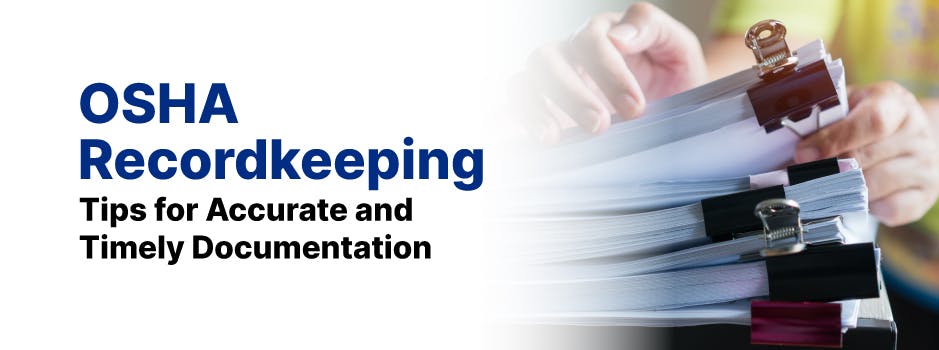Introduction
Maintaining accurate and timely documentation of workplace injuries and illnesses is a crucial aspect of OSHA compliance and an essential component of an effective workplace safety program. Proper OSHA recordkeeping helps organizations to identify trends, assess the effectiveness of safety initiatives, and develop targeted strategies for reducing workplace hazards. In this comprehensive guide, we will provide an overview of OSHA recordkeeping requirements, discuss the importance of accurate and timely documentation, and offer practical tips for maintaining OSHA-compliant records and improving workplace safety.
OSHA Recordkeeping Requirements
Overview of OSHA Recordkeeping Requirements
The Occupational Safety and Health Administration (OSHA) requires employers to maintain records of work-related injuries and illnesses, in accordance with the OSHA Recordkeeping Rule (29 CFR 1904). Key requirements include:
- Recording work-related injuries and illnesses that result in death, days away from work, restricted work or job transfer, or medical treatment beyond first aid
- Maintaining a log (OSHA Form 300) of work-related injuries and illnesses, as well as a summary report (OSHA Form 300A) and individual incident reports (OSHA Form 301)
- Retaining records for a minimum of five years and updating them as needed to reflect changes in case status or outcome
- Reporting severe incidents, such as fatalities or injuries requiring hospitalization, to OSHA within specific timeframes
Determining Recordable Injuries and Illnesses
To ensure accurate OSHA recordkeeping, employers must understand what constitutes a recordable injury or illness. In general, a case is considered recordable if it is:
- Work-related, meaning that it resulted from an event or exposure in the work environment
- A new case, not a recurrence or continuation of a previously recorded injury or illness
- Meets one or more of the general recording criteria, such as resulting in death, days away from work, or medical treatment beyond first aid
The Importance of Accurate and Timely Documentation
Benefits of Accurate and Timely Recordkeeping
Accurate and timely OSHA recordkeeping offers several benefits, including:
- Ensuring compliance with OSHA regulations and avoiding potential fines or penalties
- Facilitating the identification of trends and patterns in workplace injuries and illnesses, which can help to inform targeted safety initiatives
- Enabling organizations to track the effectiveness of safety programs and interventions, supporting continuous improvement in workplace safety
- Demonstrating an organization's commitment to employee safety and well-being, contributing to a positive safety culture
The Risks of Inaccurate or Incomplete Recordkeeping
Inaccurate or incomplete OSHA recordkeeping can have significant consequences, such as:
- Non-compliance with OSHA regulations, which may result in fines, penalties, or increased scrutiny from regulators
- Inability to accurately assess workplace safety performance, leading to ineffective or misdirected safety initiatives
- Loss of credibility with employees, stakeholders, and regulators, potentially damaging an organization's reputation and safety culture
Tips for Accurate and Timely OSHA Recordkeeping
Develop a Recordkeeping Policy and Procedure
Establish a clear policy and procedure for OSHA recordkeeping, outlining the responsibilities of various individuals within the organization, the process for documenting and reporting incidents, and the methods for maintaining and updating records. Ensure that all employees are familiar with this policy and procedure and understand their role in maintaining accurate and timely documentation.
Provide Training on OSHA Recordkeeping Requirements
Provide training to employees responsible for OSHA recordkeeping, ensuring that they understand the requirements and criteria for recordable injuries and illnesses, as well as the appropriate forms and processes for documentation. Regularly update this training to reflect changes in OSHA regulations or organizational practices.
Establish a System for Timely Incident Reporting
Implement a system for employees to promptly report workplace injuries and illnesses, facilitating timely documentation and investigation. This may involve designating specific individuals to receive reports, providing multiple reporting channels (e.g., email, hotline, in-person), and encouraging a culture of open communication and reporting.
Maintain Well-Organized Records
Keep OSHA records well-organized and easily accessible, ensuring that they can be readily reviewed and updated as needed. This may involve maintaining electronic records, using a designated recordkeeping software, or organizing paper records in a central location.
Conduct Regular Audits and Reviews
Perform regular audits and reviews of OSHA records to ensure accuracy, completeness, and compliance with recordkeeping requirements. Identify any discrepancies or gaps in documentation and address them promptly to maintain accurate records.
Utilize Recordkeeping Tools and Technology
Leverage recordkeeping tools and technology, such as software or mobile applications, to streamline the documentation process and maintain accurate, up-to-date records. These tools can also help to simplify the process of generating OSHA-required reports and summaries.
Communicate the Importance of Accurate Recordkeeping
Emphasize the importance of accurate and timely OSHA recordkeeping to all employees, highlighting the role it plays in promoting workplace safety and ensuring regulatory compliance. Encourage employees to take an active role in reporting incidents and maintaining accurate documentation.
Stay Informed on OSHA Updates and Changes
Stay informed about updates and changes to OSHA recordkeeping requirements, ensuring that your organization remains in compliance and that employees receive the most current and accurate information. This may involve subscribing to OSHA newsletters, participating in industry-specific forums or groups, or attending relevant conferences and workshops.
Conclusion
Accurate and timely OSHA recordkeeping is essential for maintaining compliance with regulatory requirements, assessing workplace safety performance, and promoting a strong safety culture within an organization. By understanding OSHA recordkeeping requirements, implementing effective policies and procedures, and leveraging tools and technology, organizations can ensure that they maintain accurate documentation and contribute to ongoing improvements in workplace safety. With a proactive approach to OSHA recordkeeping, organizations can not only avoid potential fines and penalties but also foster a safer and healthier work environment for all employees.

